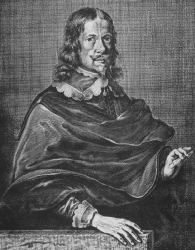




Johannes Hevelius [Hewelke] (1611-1687), from a portrait in his 1647 Selenographia. He was born on 28 January 1611 in Gdansk, Poland [later known as Danzig, then Gdansk again]. He studied Law at Leiden in 1630, then spent the years 1632-1643 traveling to Switzerland, London, and Paris, where he came in contact with various astronomers, including Pierre Gassendi (1592-1655). In 1634 he returned to Gdansk to complete his Law studies while working in his family's brewing business. He started to fully devote himself to astronomy in 1639, tapping into his family wealth to construct a private observatory in his house. His work was also sponsored by the Polish King Jan III Sobieski, through a generous pension. He died in Gdansk on January 28 1687, the day of his 76th birthday.
Hevelius was said to have exceptionally keen eyesight, to the point of being able to see stars of the seventh magnitude. Following the lead of Tycho Brahe, Hevelius constructed very large measuring instruments, and managed to improve the accuracy of measured naked-eye stellar positions down to 1 minute of arc on a routine basis, in doing so exceeding even Tycho in accuracy. With the assistance of his second wife Elisabetha, he compiled a star catalog of unprecedented accuracy, but of a lot of his data were lost in 1679 when, on September 26, his house and observatory were destroyed by fire. His Celestial Atlas, the labor of his life, was finally edited and published posthumously by Elisabetha in 1690.
In the early 1670s Hevelius was drawn in what became a heated controversy with John Flamsteed (1646-1719) and later Robert Hooke (1635-1703), who advocated the use of telescope and micrometers for accurate determinations of stellar positions. The debate came to a draw in 1679, when young Edmund Halley (1656-1742), commissioned by the Royal Society, visited Hevelius in Gdansk. Halley could but confirm to the Royal Society that Hevelius' position determination were as accurate as anything he could achieve with the state-of-the-art micrometric telescope he had taken along from England.
Hevelius was an accomplished and respected astronomer. He was elected to the Royal Society in 1664, and in 1666 was offered the directorship of the newly erected Paris observatory, an offer he declined and which eventually led to the appointment of Giovanni Domenico Cassini. Hevelius carried out numerous lunar, planetary and solar observations. On 22 November 1644 he succeeded in observing the phases or Mercury. His solar observations were published as appendices to his 1647 Selenographia, his 1668 Cometographia, as well as to his 1679 Machinae Coelistis. Hevelius used his sunspots observations to determine the solar rotation period to a much better accuracy than his predecessors. He also coined the name faculae for the bright regions surrounding sunspots, a name that survives to this day. His sunspot observations, covering the time period 1642-1679, are of particular importance as they span the first part of the Maunder Minimum of solar activity, as well as the time period immediately preceding it.
Hevelius, J. 1647, Selenographia: sive, Lunae Descriptio [Facsimile, Johnson Reprint Corporation, New York, 1967].Szanser, A.J. 1976, Quarterly J. of the Royal Astronomical Society, 17, 488-498.
 To search for a Solar Physicist
To search for a Solar Physicist
![]() To references and further reading
To references and further reading
last modification on january 18 2008 by
paulchar@astro.umontreal.ca
Tous droits réservés / Copyrighted by
Université de Montréal